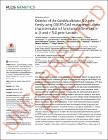| dc.contributor.author | Sullivan, Derek | en |
| dc.contributor.author | Moran, Gary | en |
| dc.date.accessioned | 2023-12-06T14:36:57Z | |
| dc.date.available | 2023-12-06T14:36:57Z | |
| dc.date.issued | 2023 | en |
| dc.date.submitted | 2023 | en |
| dc.identifier.citation | Fletcher J, O'Connor-Moneley J, Frawley D, Flanagan PR, Alaalm L, Menendez-Manjon P, Estevez SV, Hendricks S, Woodruff AL, Buscaino A, Anderson MZ, Sullivan DJ, Moran GP., Deletion of the Candida albicans TLO gene family using CRISPR-Cas9 mutagenesis allows characterisation of functional differences in ¿ - ß- and ¿- TLO gene function., PLoS genetics, 19, 12, 2023, e1011082 | en |
| dc.identifier.issn | 1553-7390 | en |
| dc.identifier.other | Y | en |
| dc.identifier.uri | http://hdl.handle.net/2262/104230 | |
| dc.description | PUBLISHED | en |
| dc.description.abstract | The Candida albicans genome contains between ten and fifteen distinct TLO genes that all encode a Med2 subunit of Mediator. In order to investigate the biological role of Med2/Tlo in C. albicans we deleted all fourteen TLO genes using CRISPR-Cas9 mutagenesis. ChIP-seq analysis showed that RNAP II localized to 55% fewer genes in the tloΔ mutant strain compared to the parent, while RNA-seq analysis showed that the tloΔ mutant exhibited differential expression of genes required for carbohydrate metabolism, stress responses, white-opaque switching and filamentous growth. Consequently, the tloΔ mutant grows poorly in glucose- and galactose-containing media, is unable to grow as true hyphae, is more sensitive to oxidative stress and is less virulent in the wax worm infection model. Reintegration of genes representative of the α-, β- and γ-TLO clades resulted in the complementation of the mutant phenotypes, but to different degrees. TLOα1 could restore phenotypes and gene expression patterns similar to wild-type and was the strongest activator of glycolytic and Tye7-regulated gene expression. In contrast, the two γ-TLO genes examined (i.e., TLOγ5 and TLOγ11) had a far lower impact on complementing phenotypic and transcriptomic changes. Uniquely, expression of TLOβ2 in the tloΔ mutant stimulated filamentous growth in YEPD medium and this phenotype was enhanced when Tloβ2 expression was increased to levels far in excess of Med3. In contrast, expression of reintegrated TLO genes in a tloΔ/med3Δ double mutant background failed to restore any of the phenotypes tested, suggesting that complementation of these Tlo-regulated processes requires a functional Mediator tail module. Together, these data confirm the importance of Med2/Tlo in a wide range of C. albicans cellular activities and demonstrate functional diversity within the gene family which may contribute to the success of this yeast as a coloniser and pathogen of humans. | en |
| dc.format.extent | e1011082 | en |
| dc.language.iso | en | en |
| dc.relation.ispartofseries | PLoS genetics | en |
| dc.relation.ispartofseries | 19 | en |
| dc.relation.ispartofseries | 12 | en |
| dc.rights | Y | en |
| dc.title | Deletion of the Candida albicans TLO gene family using CRISPR-Cas9 mutagenesis allows characterisation of functional differences in ¿-, ß- and ¿- TLO gene function. | en |
| dc.type | Journal Article | en |
| dc.type.supercollection | scholarly_publications | en |
| dc.type.supercollection | refereed_publications | en |
| dc.identifier.peoplefinderurl | http://people.tcd.ie/djsullvn | en |
| dc.identifier.peoplefinderurl | http://people.tcd.ie/gmoran | en |
| dc.identifier.rssinternalid | 260599 | en |
| dc.identifier.doi | http://dx.doi.org/10.1371/journal.pgen.1011082 | en |
| dc.rights.ecaccessrights | openAccess | |
| dc.subject.TCDTheme | Genes & Society | en |
| dc.subject.TCDTheme | Immunology, Inflammation & Infection | en |
| dc.subject.TCDTag | Genomes, Genomics | en |
| dc.subject.TCDTag | Molecular Biology | en |
| dc.subject.TCDTag | Mycology and fungal pathogenesis | en |
| dc.subject.TCDTag | Oral microbiology | en |
| dc.identifier.orcid_id | 0000-0003-0195-9697 | en |
| dc.status.accessible | N | en |
| dc.contributor.sponsor | Science Foundation Ireland (SFI) | en |
| dc.contributor.sponsorGrantNumber | 19/FFP/6422 | en |




